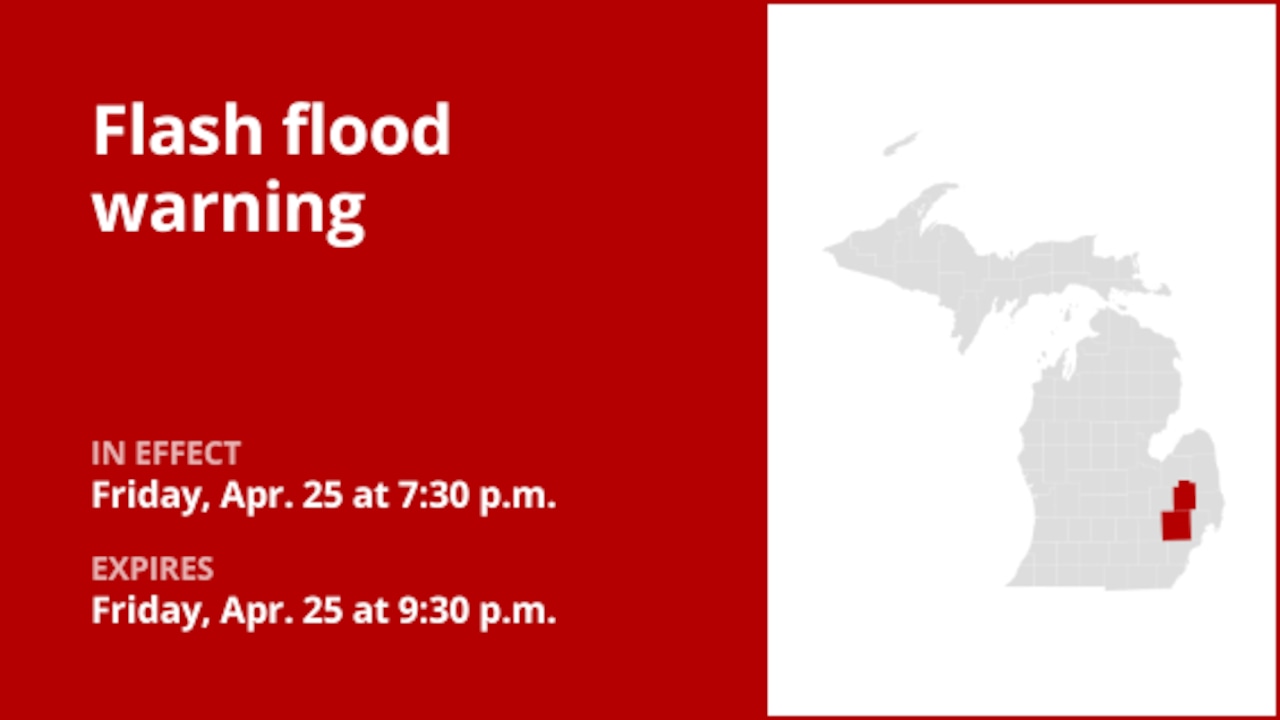A flash flood warning has been issued for Lapeer and Oakland counties until 9:30 p.m. EDT. The National Weather Service reports that severe thunderstorms are producing heavy rainfall, leading to potential flash flooding in these areas. Residents are urged to take immediate precautions to ensure their safety.
This alert underscores the importance of being prepared for sudden and intense weather events. Flash floods can develop rapidly, posing significant risks to life and property. Understanding the warning signs and following safety guidelines is crucial during such situations.
This article will provide you with the latest information on the flash flood warning, affected areas, and essential safety tips to help you stay safe during this weather event. We’ll cover key recommendations from the National Weather Service and expert guidance on navigating flood-related hazards.
Flash Flood Warning Details
As of 7:30 p.m. EDT on Friday, the National Weather Service has issued a flash flood warning for Lapeer and Oakland counties, effective until 9:30 p.m. EDT. Doppler radar indicates that thunderstorms are producing heavy rain across the warned area, with rainfall rates of 1 to 2 inches per hour.
Between 1.5 and 3 inches of rain have already fallen, and additional rainfall of 1 to 2 inches is possible. This heavy rainfall is expected to cause flash flooding of small creeks, streams, urban areas, highways, streets, underpasses, and other poorly drained and low-lying areas.
The weather service emphasizes the immediate threat, stating, “Flash flooding is ongoing or expected to begin shortly.” This urgent warning calls for immediate action to protect yourself and your property.
Locations Impacted
The flash flood warning affects several locations in Lapeer and Oakland counties. These include:
- Oxford
- Ortonville
- Dryden
- Metamora
- Lake Orion
- Leonard
- Thornville
- Lakeville
Residents in these areas should be particularly vigilant and take necessary precautions to avoid flooded areas. Monitor local news and weather updates for the latest information.
Essential Safety Tips During a Flash Flood
The National Weather Service stresses the importance of safety during a flash flood. Here are critical guidelines to follow:
“Turn around, don’t drown when encountering flooded roads. Most flood deaths occur in vehicles.”
Key safety measures include:
- Move to Higher Ground: If you are in a flood-prone area, immediately move to higher ground.
- Adhere to Evacuation Orders: If local authorities issue an evacuation order, comply promptly. Secure your home by locking it before leaving.
- Disconnect Utilities: If time allows, disconnect utilities and appliances to reduce the risk of electrical hazards.
- Avoid Flooded Areas: Steer clear of flooded basements and submerged areas to prevent electrical accidents.
- Evacuate Immediately if You Notice Sparks: If you notice sparks or hear unusual noises, evacuate immediately and avoid any water that may be charged with electricity.
Understanding Weather Alerts
It’s essential to understand the different types of weather alerts issued by the National Weather Service. Here’s a breakdown:
- Flash Flood Warning: Take action! A flash flood is imminent or occurring. Move to high ground immediately.
- Flood Warning: Take action! Flooding is on the verge of happening or is already underway.
- Flood Advisory: Be aware! Flooding is not expected to be severe enough to issue a warning, but it may cause significant inconvenience.
- Flood Watch: Be prepared! Conditions are favorable for flooding. Stay informed and be ready to take action.
Knowing the difference between these alerts can help you respond appropriately and stay safe.
Driving Safety Guidelines for Wet Roads
Driving during heavy rainfall can be hazardous. Follow these tips from the weather service to ensure your safety:
- Beware of Swollen Waterways: Avoid parking or walking near culverts or drainage ditches.
- Maintain Safe Driving Distances: Use the two-second rule, adding an extra two seconds in heavy rain.
- Slow Down: Reduce your speed and avoid sudden braking.
- Choose Your Lane Wisely: Stick to the middle lanes to minimize hydroplaning risk.
- Prioritize Visibility: Use headlights and be vigilant for vehicles in blind spots.
- Watch Out for Slippery Roads: Exercise caution during the first half-hour of rain.
- Keep a Safe Distance from Large Vehicles: Avoid following large trucks too closely to maintain visibility.
- Mind Your Windshield Wipers: Ensure wiper blades are in good condition. If visibility is severely impaired, pull over and wait for conditions to improve.
Conclusion: Stay Safe and Informed
The flash flood warning for Lapeer and Oakland counties underscores the importance of staying informed and prepared during severe weather events. Remember to take immediate action if you are in an affected area, and always prioritize your safety.
By understanding weather alerts, following safety guidelines, and making informed decisions, you can significantly reduce the risks associated with flash floods. Stay tuned to local news and weather updates for the latest information, and always heed the advice of local authorities.
Advance Local Weather Alerts, provided by United Robots, uses machine learning to compile the latest data from the National Weather Service. This ensures that you receive timely and accurate information to help you stay safe during severe weather conditions. Remember, “Turn around, don’t drown” – your safety is the top priority.

Leave a Reply